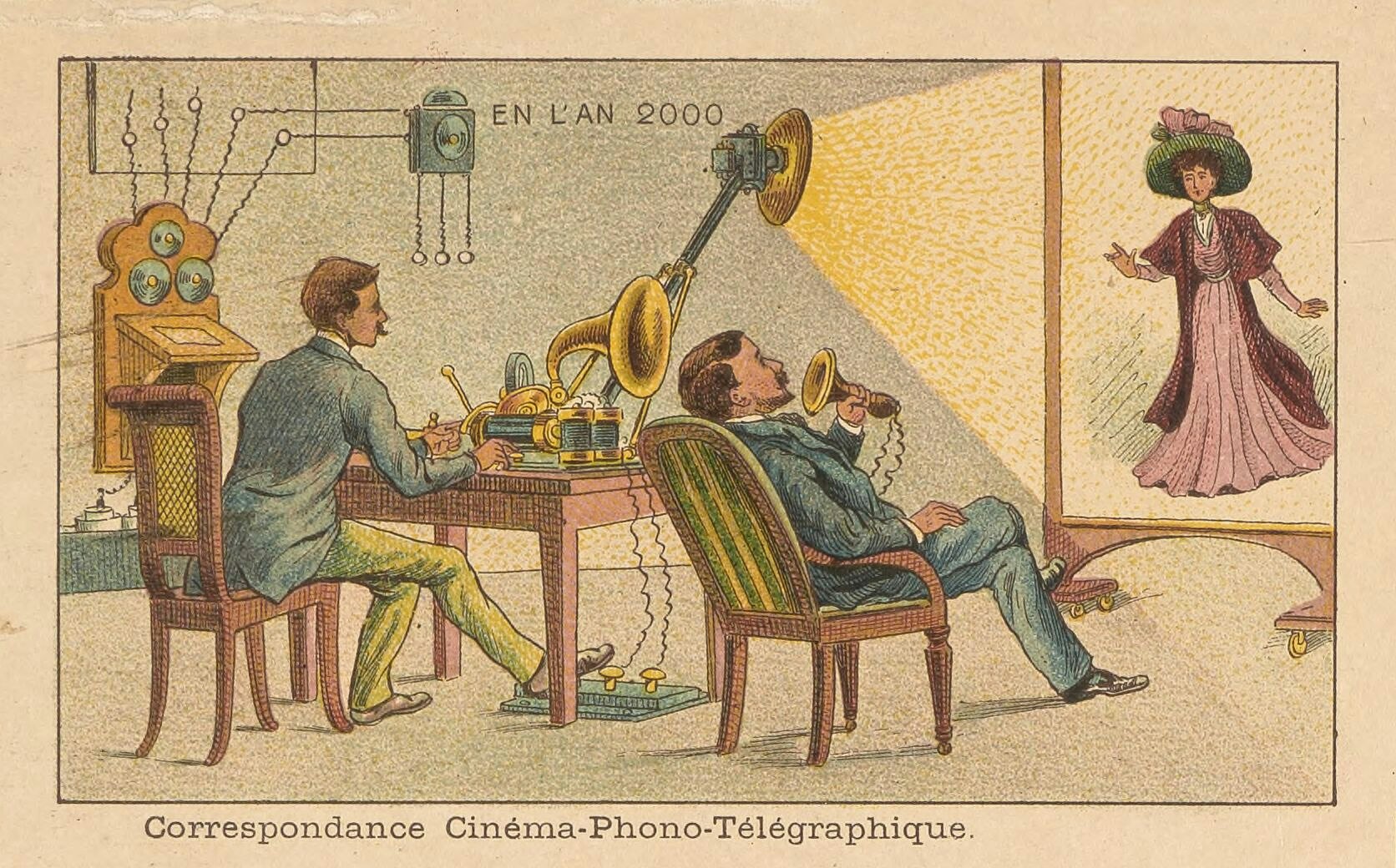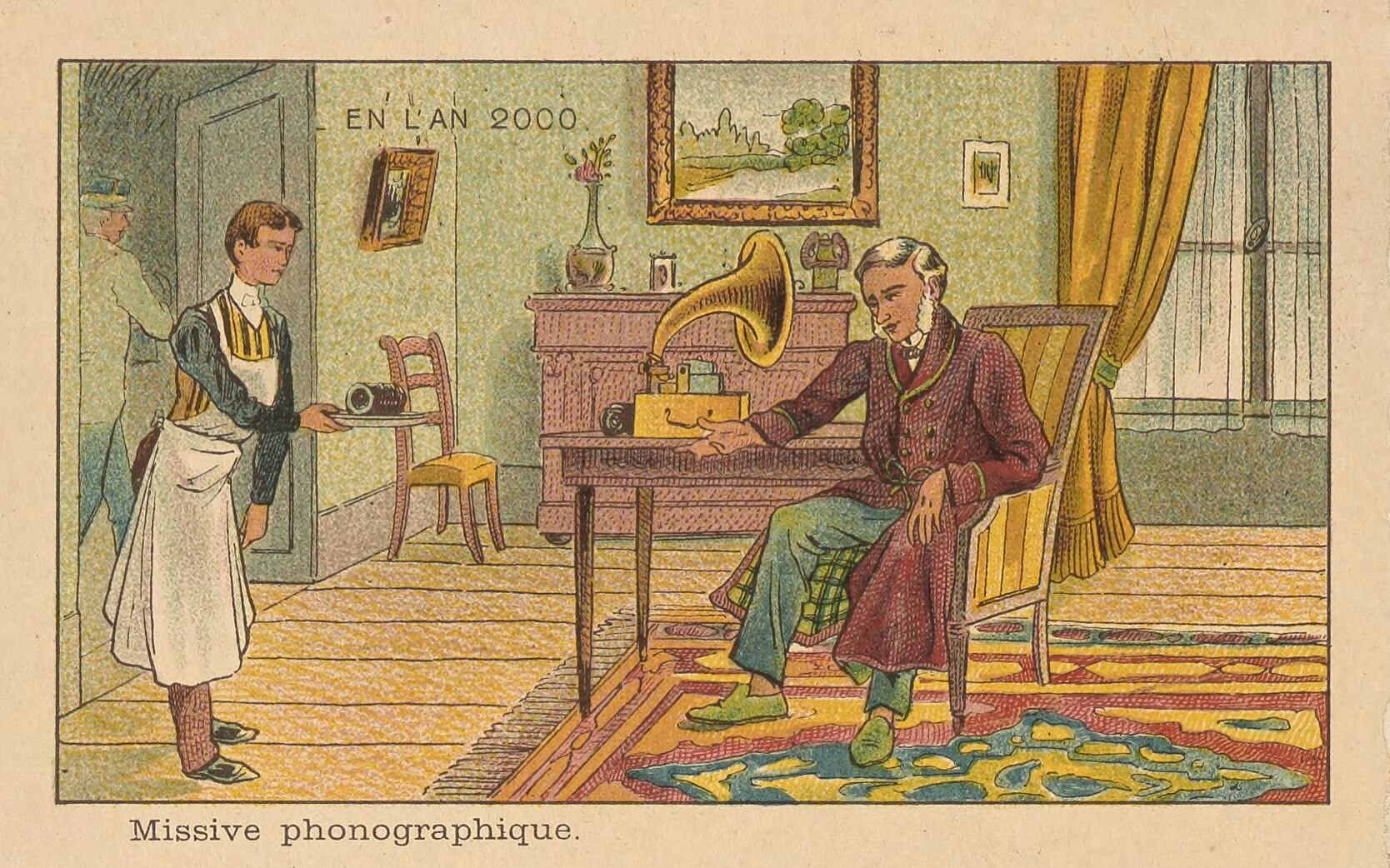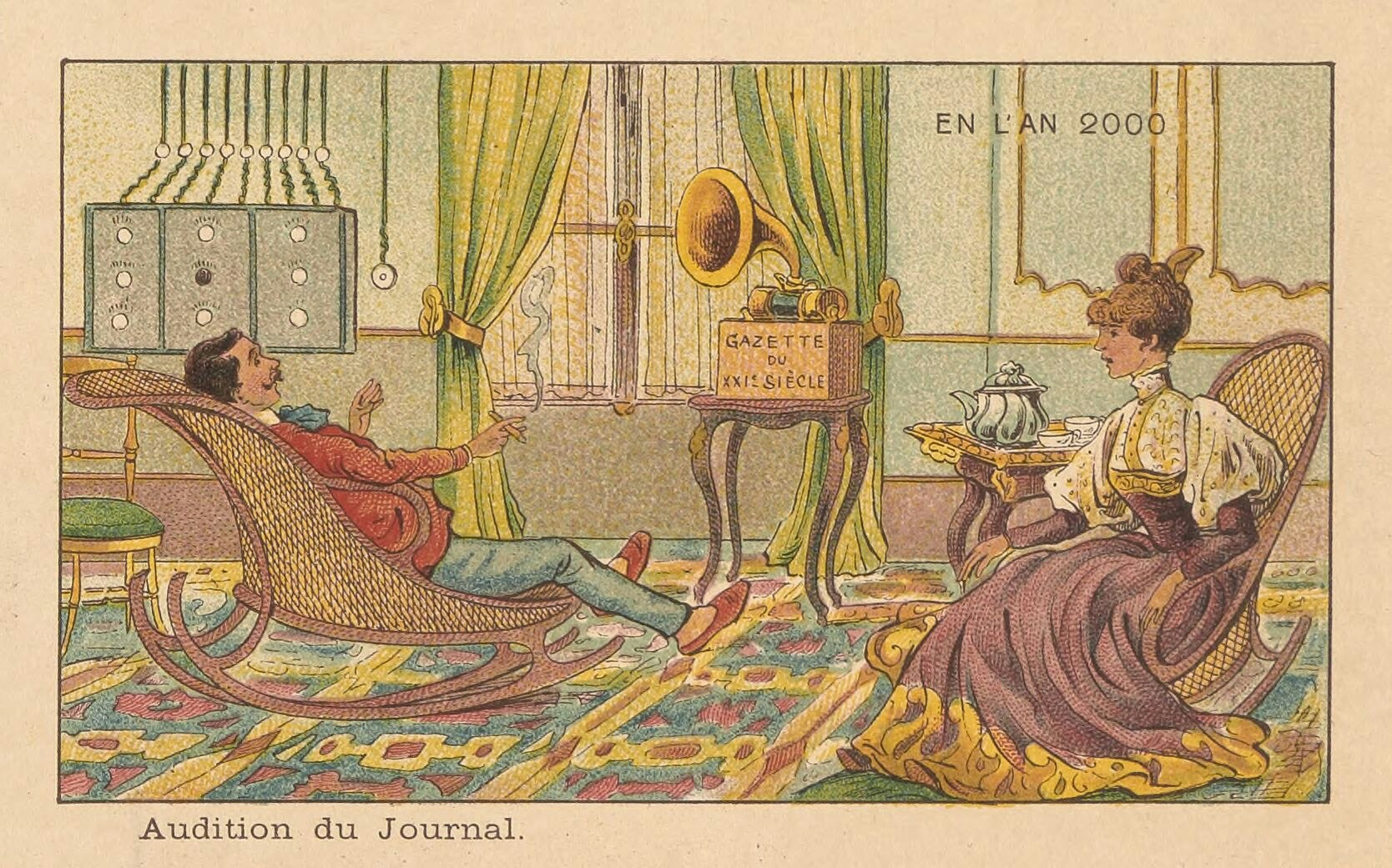Past Futures
« previous post | next post »
From "Lost Futures: A 19th-Century Vision of the Year 2000", The Public Domain Review, 6/30/2012:
What did the year 2000 look like in 1900? Originally commissioned by Armand Gervais, a French toy manufacturer in Lyon, for the 1900 World exhibition in Paris, the first fifty of these paper cards were produced by Jean-Marc Côté, designed to be enclosed in cigarette boxes and, later, sent as postcards. All in all, at least seventy-eight cards were made by Côté and other artists, although the exact number is not known, and some may still remain undiscovered. Each tries to imagine what it would be like to live in the then-distant year of 2000.
Some of the images are related to linguistic communication, for example this Zoom-like interaction:
Of course, given the wax cylinders and foot pedals, as well as the label "Correspondance", the idea was not actually real-time interactions, but rather an exchange of audio-visual recordings, sort of like sending DVDs back and forth via the post office.
The snail-mail character of the imagined network is even clearer in in this vision of "phonographic letters":
And the vision (below) of "listening to the newspaper" — again delivered on wax-cylinder recordings — reminds me of the the AT&T executives in the 1980s, whose response to Bill Dunn's vision of networked digital news was to fund the development of "a cheap-enough piece of hardware combining a modem, a printer, and a cassette recorder, so that subscribers could download a personalized news feed in the wee hours of the morning (when telephone bandwidth was essentially free), and have their choice of a printed or spoken version waiting at breakfast time":
There are lots more remarkably confused predictions where those came from, so have fun!



Coby said,
March 6, 2024 @ 11:25 am
What I find funny about these cards is not only the short-sightedness of the technological forecasts, but the assumption that the fashions of 1900 would last for another century.
Philip Taylor said,
March 6, 2024 @ 12:30 pm
I agree that "the assumption that the fashions of 1900 would last for another century" is odd, Copy, but do you think that anyone might have reasonably have predicted how we would dress in the year 2000 ? Different to then, certainly, but how close might they have reasonably got to the reality ?
Linda Seebach said,
March 6, 2024 @ 1:24 pm
And that the household would have servants to deliver these modern marvels.
Thomas said,
March 6, 2024 @ 1:34 pm
The prediction of such volatile things like fashion in a distant future is a good application of the naive prediction method known as "last value predictor". If we have no idea in which direction the development might go and we do not have a sort of long-term mean to resort to, this is actually a good method, and it has the advantage that it is model-free.
Cervantes said,
March 6, 2024 @ 2:13 pm
Technological change moved much more slowly in 1900 than it does now, so we're likely to see the future as more radically different than they did back then, but that doesn't mean we can imagine it accurately.
I would say some of the misses in this are understandable, others less so. For example, the telephone had existed for some time, so one might have foreseen that it would become pervasive. But the first radio communication was in 1901, so it's no surprise these people didn't anticipate it as a commonplace.
As for clothing, yes, there's no way to predict fashion. Actually men's clothing has changed little. These guys are wearing clothing that wouldn't seem bizarre today, except their casual home wear would be formal wear today. Women's skirts have gotten shorter, they're allowed to show their legs now, and they can wear pants if they want. Our bodies haven't changed, though, so the basic ideas of clothing are still pretty similar.
DG said,
March 6, 2024 @ 2:21 pm
I also think the sort of people who do scifi-type technical predictions like these, are a very different set from the people who'd be doing fashion predictions. I am sure if you asked artists to make fashion predictions instead, they would come across as more reasonable, but they wouldn't do a good job on technology.
David Marjanović said,
March 6, 2024 @ 4:49 pm
Predictions from 1950 onwards about the year 2000 and later haven't held up much better.
Not a naive speaker said,
March 6, 2024 @ 5:03 pm
Listening to the newspaper was already invented in the 1890s
https://en.wikipedia.org/wiki/Telephone_newspaper
J.W. Brewer said,
March 6, 2024 @ 6:08 pm
The men's fashions would look odder if the pictures were bigger and some of the period details more prominent. Photos of a generic "man in fairly plain/dark business suit and tie" back to around 1925-1930 can look like (if no background details intrude) like they wouldn't be out of place today, but there were a bunch of cumulatively significant changes in the early decades of the 20th century.
And of course there were some who did not adopt the new-fangled and less formal fashions of the Coolidge/Hoover era. 30+ years ago when I was fresh out of law school I spent time in a federal courthouse where the old-timers would pass on stories about the old days, including the tidbit that Judge So-and-so, who had remained on the bench until his death in (checking wikipedia …) 1957, was thought to have been the last man in the state, or at least its legal community, to continue to routinely wear spats as part of his ordinary weekday going-to-work outfit.
Jim Breen said,
March 6, 2024 @ 7:11 pm
I remember an Arthur C Clarke SF novel in which a journalist joined a 2000s trip to Mars. His camera (still) had an external light meter.
And one of John Brunner's novels had interstellar spaceships sending each other text messages all in upper case with"STOP" at the ends of sentences, as if the 5-bit Baudot code was still in use in the 2100s.
Viseguy said,
March 6, 2024 @ 8:10 pm
@David Marjanović: "Predictions from 1950 onwards about the year 2000 and later haven't held up much better."
A notable exception is Vannevar Bush's classic essay in the July 1945 issue of The Atlantic, entitled "As We May Think", in which he anticipates the advent of inventions including the fax machine, hypertext and the internet (which he dubbed the "memex"). It's a masterpiece of prediction based on reasonable extrapolations from then-current technology, with which Bush was, of course, deeply familiar. With the end of the war on the horizon, Bush exhorts scientists to turn their energies to peaceful, life-improving technologies such as the ones he foresaw — though his timing proved ironic given that the piece was published a month before the U.S. dropped two atomic bombs on Japan.
Phillip Helbig said,
March 7, 2024 @ 1:34 am
https://digital-world.itu.int/life-in-france/
“The images were to depict how life in France would look in a century’s time, no doubt heavily influenced by Verne’s writings. Sadly, they were never actually distributed. However, the only known set of cards to exist was discovered by Isaac Asimov, who wrote a book in 1986 called “Futuredays” in which he presented the illustrations with commentary.”
As an Asimov fan, I ran across these some time ago.
Phillip Helbig said,
March 7, 2024 @ 1:36 am
Yes, there are many predictions which didn’t predict enough progress, such as Clarke (who invented the idea) having a human (female, of course) switchboard operator inside the first communications satellite.
On the other hand, Clarke described the internet in everything but name decades before it existed: working from home, virtual communities, information at your fingertips, digital library. He even wrote a story about how most of the bandwidth is used for porn.
Philip Anderson said,
March 7, 2024 @ 5:28 am
@Linda Seebach
Since the middle classes had had servants since time immemorial, that was a natural assumption. The disappearance of servants has been a seismic change, arguably more significant than technology and unlike that completely unexpected. Was it predictable, except to Marxists?
Tom Dawkes said,
March 7, 2024 @ 9:00 am
@Phillip Helbig. The last item of Clarke's that you mention is "I remember Babylon". The narrator mentions that the transmission of sexually explicit images from various sources via a stallite would be beyond government intervention.
Coby said,
March 7, 2024 @ 9:04 am
My point wasn't that the predictions were inaccurate, but, given that fashions have always changed (compare those of 1900 with the Empire style of 1800), that the artist(s) hadn't thought that they would change from 1900.
Philip Anderson said,
March 7, 2024 @ 5:47 pm
@Thomas
I agree they didn’t have a clue what fashion might be like, but as Coby says, it would definitely change. So implying no change was guaranteed to be wrong, whereas any guess had some chance of being in the right direction.
Gobbledyglot said,
March 8, 2024 @ 7:20 am
@Jim Breen: "I remember an Arthur C Clarke SF novel in which a journalist joined a 2000s trip to Mars. His camera (still) had an external light meter."
It's always interesting to delve into science fiction from the golden era. Here is Isaac Asimov, writing in the early 1950s:
"R. Daneel placed the small, stamp-size cards before Baley. They were mottled with the small dots that served as code. The robot also produced a portable decoder and placed one of the cards into an appropriate slot. The dots possessed electrical conduction properties different from that of the card as a whole. The electric field passing through the card was therefore distorted in a highly specific manner and in response to that specification the three-by-six screen above the decoder was filled with words. Words which, uncoded, would have filled several sheets of standard size report paper. Words, moreover, which could not possibly be interpreted by anyone not in possession of an official police decoder."
This is set explicitly set several thousand years into the future, because not five pages later, Baley says that humans "have been building robots for several thousand years".
Howard Ross said,
March 8, 2024 @ 4:31 pm
How much of the fact that the images under-estimate the amount of social and technical change may be due to the need of the artists to create images that were meaningful to the people of 1900? The images appear to be more conceptual than technically accurate.
Bloix said,
March 9, 2024 @ 12:13 am
You don't have to go back a hundred years to get the future wrong.
True story:
In June 1978 I was a senior at a small liberal arts college who hadn't managed to complete my senior thesis on time, and I was trying to get it done before July 4th so I'd be counted as graduating with my class. Because it was summer, I could use the computer center, which had 20 terminals, to do word processing. I would check in at the desk, manned by a physics major (no computer science majors yet) who stood in front of a door behind which was the massive mainframe with its spinning two-inch tapes, and find an empty terminal. This could be difficult, because many were occupied by people playing Adventure, a text-only game where players found their way to a treasure through a maze of tunnels while avoiding falling off cliffs, getting lost and starving, and being killed by goblins. The screen would say, "you are standing in front of a cave," you would type "enter the cave," the screen would read, "you are inside a dark cave. On the floor there is lantern. There are three tunnels, left, center, and right." You'd type "pick up the lantern," and you were on your way.
I started playing, too, and it was a fascinating time-sink. I never found the treasure, but I did make it to the underground waterfall. There on the screen were the words, pixelated and bright green: "You have entered a high-ceilinged cavern, with massive, glistening stalactites hanging from the ceiling, and in front of you a thunderous waterfall pouring through a high cave in the wall of the cavern and falling a hundred feet into a swift-flowing river." It was exciting!
That day, as I was checking out, I said to the physics major, "some day that Adventure game will have pictures, and you'll be able to move around and do stuff, and the goblins will chase you, and it will all be in color." He looked at me with utter contempt, as he said, "Do you have ANY IDEA how much memory that would take?"
/df said,
March 11, 2024 @ 11:32 pm
Let's say, 512MB, like a PS3, or almost 200x the RAM of the Cambridge University mainframe at that time.
By 1900, transmission of pictures by telegraph had been invented (ahead of the telephone itself) and improved over several decades. It might have been predicted that another century of development would lead to real-time audiovisual transmission, but the artists of 1900 could have no idea of how the corresponding video display would work: cathode ray tubes were only just known to science.